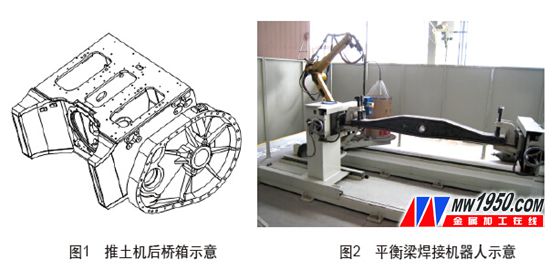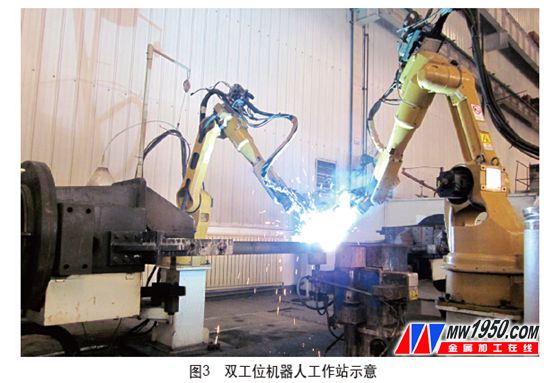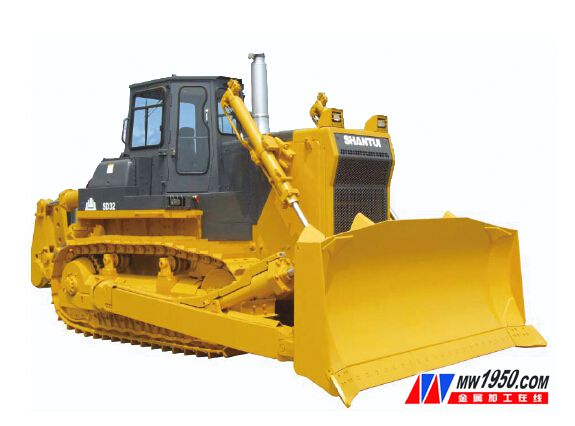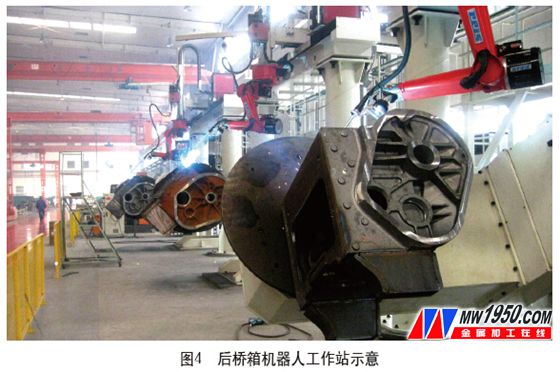With the rapid development of science and technology, in the construction machinery industry, the production and manufacturing process of products gradually tends to be refined management, the requirements for product quality are becoming more and more strict, the degree of production automation is getting higher and higher, and the application of some digital intelligent equipment is becoming more and more widely. After many years of accumulation and development, digital intelligent equipment has made great progress in the field of structural parts welding. It has automation equipment such as welding production model line and welding robot workstation, and has achieved domestic leading in product quality and production capacity. Level. This article will introduce the digital intelligent equipment in recent years - the production and application of welding robots in Shantui.
First, the structure of the welding robot
The welding robot is a welding production unit consisting of a robot, a control cabinet, a positioner, a welding device, and an arc welding software. The robot is the main body that completes the welding action, and generally refers to the 6-axis robot body, which is driven by the servo motor to drive various axes on the arm to achieve various actions. The control cabinet is equipped with a computer software control system. Its function is to control the servo motor on the robot body through the servo amplifier to realize the coordinated movement of the robot. The second is to realize the software functions such as starting point searching and arc tracking. The function of the positioner is to install the fixed workpiece and accurately position the workpiece. During the welding process, the workpiece can be rotated to achieve the ideal welding posture, and can be linked with the robot. Nowadays, the form of the commonly used positioner mainly has L-shaped displacement. Machine and headstock positioner. Welding equipment mainly includes welding power source, welding torch, wire feeding device, water cooling device and welding torch cleaning wire cutting device.
Second, the welding function of the welding robot system
Shantui's application of robot-welded workpieces is generally constructed of medium-thick steel plates. It is inevitable that there will be errors in the pairing. The position and width of the welds are not consistent. During the welding process, the welds are welded first. The deformation acts on the workpiece, causing the weld to be welded to deviate from the position of the pair. In order to ensure the welding quality, the robot is required to automatically find the starting position and the correct direction of the weld during welding. The robot system for welding the plate will have the functions of welding starting point searching and seam tracking.
1. Weld seam starting point locating function
At present, the welding robots used by Shantui mainly include the Kobelco ARCMAN series and the German Muse robot system. The starting point of the weld is the contact sensing position, which uses the welding wire with low voltage to contact the surface of the workpiece for three-way transmission. Sense, in this way to perceive the actual workpiece position, through the program to calculate the actual position and the offset of the workpiece surface position during teaching, and then add the offset to the welding position when teaching, find the correct welding position, correct the loading The deviation of the welding position caused by the clamp, the pair, and the welding can achieve the purpose of ensuring the welding quality.
2. Arc tracking function
After the position of the starting point is determined, the correctness of the welding direction also needs to be ensured by the arc tracking function. Arc tracking means that during the welding process, the arc welding robot system monitors the change of the welding voltage and current in real time through software, analyzes and calculates the change of the arc length, and corrects the deviation of the weld by adjusting the posture of the robot through software. At present, the arc welding robot system used by Shantui uses the welding seam starting point searching and arc tracking to carry out the application of the rear axle box welding of the bulldozer, and the work reliability is good and the quality is stable.
3. Groove width tracking function
The groove width tracking refers to the arc welding robot system detecting multiple points on the whole weld before welding, and calculating the width of the weld groove by software, and then obtaining the change of the groove width of the whole weld, During the welding process, the welding swing amplitude and welding speed of the robot are adjusted to obtain the weld seam with the same residual height, so as to improve the welding quality. That is, the swing width is increased at a wider weld seam, and the welding speed is reduced; the swing width is appropriately reduced at a narrow weld seam, and the welding speed is accordingly increased. At present, this function is applied to the welding of various products in the Shantui arc welding robot system, and the weld bead is formed well and the quality is stable.
Third, the production and application of welding robot system in Shantui
1. Introduction of bulldozer structural parts
The main workpieces produced by Shantui's application of arc welding robots are the rear axle box of the bulldozer, the balance beam, the trolley box and the main frame. The welds of these workpieces have a straight weld of up to 4m (trailer box). There are also welds with complex and short space in a dense space (see Figure 1 for the rear axle box); most steel plates are between 10 and 30 mm thick and belong to the welding of medium and heavy plates; the welding method is the fusion pole CO2 gas shielded welding.
2. Welding robot system composition
According to the characteristics of the structural components of the bulldozer, the arc welding robot system mainly has three forms: one is the single station, the robot gantry type moving, the L arm type positioner, the 11 axis linkage, which is mainly used for the welding of the rear axle box of the bulldozer; The second is single station, robot moving skateboard, head and tail frame positioner, 8-axis linkage, mainly used for welding of balance beam (see Figure 2); the third is the former upgrade, it is duplex It is mainly used in the welding of trolley boxes (see Figure 3).
3. Welding robot flexible production
In the production, by changing the procedure of the welding robot, it is possible to produce different types of products, and it is also possible to realize the welding automation of the batch products without having to re-purchase the new welding equipment, which fully embodies the advantages of the flexible production of the welding robot. The realization of flexible production requires the versatility of the positioner fixture and the completeness of the welding procedure. When the product is changed, only the fixture needs to be replaced and the corresponding program is called up, and the welding robot can automatically complete the welding production of the workpiece. Effectively shorten the cycle of product modification and reduce the advantages of the corresponding equipment investment.
Fourth, the significance of the application of welding robot system
1. Effectively improve weld quality, ensure uniformity and stability
Welding parameters such as welding current, arc voltage, welding speed and wire dry elongation determine the welding results. When using robot welding, the welding parameters for each weld are constant, the weld quality is less affected by human factors, and the requirements for the worker's operating technology are reduced, so the welding quality is stable. In the case of manual welding, the welding speed and the dry elongation are all changed, so that it is difficult to achieve uniformity of quality.
The welding machine can not sense the change of welding conditions, and can not automatically adjust the welding parameters. The arc welding robot system has the function of locating and tracking. It automatically corrects the welding parameters according to the welding conditions and controls the welding process in real time. Greatly improved the quality of welding.
2. Effectively improve workers' working conditions
After the teaching of the arc welding robot system is completed, all the welding work of the same workpiece can be automatically completed. Basically, no manual adjustment is required. The worker only needs to perform simple operations such as loading and unloading the workpiece and pressing the button after welding, away from the welding arc and Smoke, splashes, etc., improve the labor intensity of workers (see Figure 4). The use of welding machine welding process requires manual adjustment of parameters, it is impossible to fully automatic, and the labor conditions of workers are limited.
3. Effectively improve labor productivity
The robot is not fatigued and can be continuously produced 24 hours a day. In addition, with the application of high-speed and high-efficiency welding technology, the use of robot welding increases the efficiency. Take the SD32 bulldozer rear axle box as an example. One day of manual welding (double shift production) can be welded one by one, and the arc welding robot system can be used for welding (double shift production) can weld 2.5 sets, the production efficiency is improved by more than 100%, and the elimination is also omitted. When the rollover takes up the driving time, the welding quality is more reliable, and the safety hazard when the workpiece is turned over is eliminated, and the labor productivity is greatly improved.
4. Product cycle is clear, easy to control product output
The production cycle of the robot is fixed, and the production plan is very clear. The application of the arc welding robot brings us tangible benefits. At the same time, we also see some shortcomings in the use of arc welding robot systems. For example, the one-time investment is large, and the arc welding robot system has a complicated structure, involving multiple systems such as robot motion control system, welding system, and positioner system. Coordinated operation; the robot body is expensive, and there is no large-scale production capacity in the country, mainly relying on imports; it is because of the complexity and precision of the equipment, which puts high demands on maintenance personnel, and sometimes requires the assistance of manufacturers; Higher requirements are placed on the quality of the operating equipment workers. Teaching and programming, troubleshooting, etc. all require certain professional knowledge and need to be trained.
V. Conclusion
The successful application of the arc welding robot system in the welding of Shantui structural parts has improved the production efficiency and quality of the products, reduced the labor intensity of workers, realized flexible management, and facilitated production control, bringing tangible benefits to Shantui; We also see that there is still a big gap between our automation level and foreign companies. As the leader in the bulldozer production industry, Shantui should continue to promote the application of high-tech technical equipment, improve productivity, and promote the healthy development of the bulldozer production industry. Finally, I hope that the design and production of robotic bodies in China can grow and develop.
More exciting content Welcome to Metalworking Online》》》Essen Special Report

The 19th Beijing Essen Welding & Cutting Fair
Potassium (K) is one of the three essential macronutrients, along with
nitrogen and phosphorus. Potassium is vital for a plant to resist
drought and disease as well as for promoting healthy growth. Your crops
need proper potassium levels to assure quality, appearance, overall
yield and harvest success.
Potassium Fertilizer
Potassium Fertilizer,Potassium Sulphate,Potasisum Sulfate,Phtassium Nitrate
Hebei Monband Water Soluble Fertilizer Co., Ltd. , https://www.wsfertilizer.com




